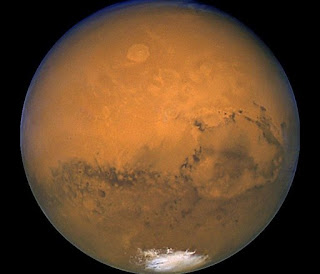 |
| © AFP/NASA/File |
WASHINGTON (AFP) – NASA should focus its efforts on a solar-powered rover mission to Mars rather than human spaceflight in the coming decade, but only if costs can be slashed, a science panel said Monday.
The recommendation was part of a report by the National Research Council urging a series of planetary missions “that could provide a steady stream of important new discoveries about the solar system” from 2013 to 2022.
The report comes as NASA faces scrutiny from lawmakers over its proposed 2012 budget and pressure from the public to find a new way to transport astronauts into space once the three-decade old shuttle program ends this year.
“The committee is concerned that, as demonstrated in the recent past, human spaceflight programs can cannibalize space science programs,” it said, urging budget firewalls between science-driven space missions and human spaceflight.
“Human exploration can provide important opportunities to advance science, but science is not the primary motivation,” it said.
“If the Apollo experience is an applicable guide, robotic missions to targets of interest will undoubtedly precede human landings.”
The Mars project, known formally as the Mars Astrobiology Explorer Cacher (MAX-C), aims to help scientists figure out if life ever existed on the red planet and would be a joint venture with the European Space Agency for launch in 2018.
“The martian surface preserves a record of earliest solar system history, on a planet with conditions that may have been similar to those on Earth when life emerged,” the report said.
“It is now possible to select a site on Mars from which to collect samples that will address the question of whether the planet was ever an abode of life.”
But the current scope of the rover plans are too wide and must be narrowed to shave a billion from the costs, set by independent experts’ estimates at $3.5 billion, and “ensure that both agencies still benefit.”
The second priority should be exploring Jupiter’s icy moon Europa as a potentially livable environment, the Council said.
“This moon, with its probable vast subsurface ocean sandwiched between a potentially active silicate interior and a highly dynamic surface ice shell, offers one of the most promising extraterrestrial habitable environments in our solar system and a plausible model for habitable environments outside it.”
There too, prohibitive costs associated with the mission must be cut back, otherwise “it would lead to an unacceptable programmatic imbalance, eliminating too many other important missions,” the report said.
The projected cost of the Jupiter Europa Orbiter (JEO) is $4.7 billion by fiscal year 2015.
“Therefore, while the committee recommends JEO as the second highest priority Flagship mission, close behind MAX-C, it should fly in the decade 2013-2022 only if changes to both the mission and the NASA planetary budget make it affordable without eliminating any other recommended missions.”
The report was requested by NASA and the National Science Foundation “to review the status of planetary science in the United States and to develop a comprehensive strategy that will continue these advances in the coming decade.”
The recommendations were based on science return per dollar, the effort to achieve balance among missions and among targets in the solar system, and technological readiness.
Other priority projects should be the Uranus Orbiter and Probe mission, and the continuation of the Discovery program involving scientist-devised team projects to explore space, which the report described as “highly successful.”
President Barack Obama’s 2012 budget blueprint to Congress calls for a five-year freeze on spending levels at the US space agency, restricting NASA’s budget to $18.7 billion annually through fiscal 2016.
The figure represents a 1.6-percent decrease from the spending total the agency had sought for fiscal 2011, which ends in September.
Private industry is working on a space capsule and heavy lift rocket that will some day take astronauts into space, a project NASA hopes will be up and running by 2015 or 2016. No contract has been signed yet.
“If the development of a heavy-lift launch vehicle proceeds as planned, the surface of the Moon or a near-earth asteroid is potentially accessible by humans sometime after 2022,” the report said.
© AFP — Published at Activist Post with license


Be the first to comment on "Mars should be US space agency’s focus: panel"